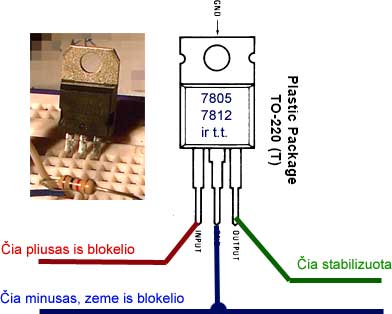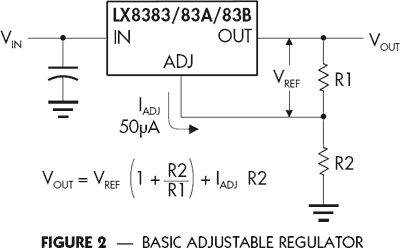This blog entry is for beginners. Sometimes I receive letter with questions from beginners.
So, the question: how to build very simple voltage regulator? For fixed (3.3, 5, 6, 12, 15V) or adjusted output. The simples way is to use special chip- linear regulator. The unnecessary voltage are disposed by the heat. So this type of regulator typically use heat sink. As bare chip version is only of a few watt power output.

According to the datasheet, there must be some capacitors. But the main element is three leg element. Center connector and the screw tab is connected to ground.
The chip can be named with various additional symbols, but the main series of those chips carry 78xx mark. For example, the 5V regulator is named 7805, 12V – 7812 and etc. The full name for chip for national semiconductors is LM7805C. The low power version carry 78L05 mark on the body of the chip.
Soviet copy of the chip is called “KREN”. It is from shortened marking. The full name of Russian chip is КР142ЕÐ5 (for 5V version). The chip is carrying shortened version “КРЕÐ5”, and it sounds like “KREN5”.
TO220 case chip can pass 1…2A current (depends of model). Typically the chip has build in protection from over current and overheating. But always check the datasheet. Max temperature of the case is 70…80 degrees of centigrade. Theoretical maximal power from the chip is 20W using endless heat sink. Bare chip can dispose about 2W of heat. Using real heat sink- 5…10W. How to calculate this power? Just few lines of math:
For example, we want to build some PSU to use in the car. Typically, the power in the car is from 12V (when engine is off) to 14V (with started engine). Assume that output will be 5V @ 1A. We must calculate with biggest possible values.
Udrop=Ucar-5V=14-5=9V
The power dissipated on the regulator:
P=U*I=9*1=9W. (And is the current increases, the power is going very high- at 2A it is 18W)
So, we must dissipate 9W of heat. It is more than 1…2W, so we need heat sink.
Sometimes, when connecting regulator to wall “brick” adapter we must use the heat sink, as output from rectifier is much more than stated on the label. Measure the voltage with required load. I’ve seen adapters where output was 25V at 250mA load when label was 12V!
So:
P=20*0.25=5W (!) And we need heat sink with this adapter. Especially if it is placed in closed box…
One more parameter- max input voltage. It is about 35V for 7805. Read the datasheet.
Other interesting parameter minimal dropout voltage. This means how the voltages must differ from input to output to put linear regulator to normal working condition. This can be obtained from datasheet. For example, 7805 need nor less than 7.5V input. There are new series of low dropout voltage regulators. Like LX8383. It need on 1.3 … 1.5V dropout for normal work. The max current is much more- 7.5A max, but the input voltage is much lower.
How to make adjustable regulator? Very simple, just enter resistor network to divide voltage:

Similar resistor network can be used with 78xx chips. It is possible to put trimmer and to adjust output voltage. Later, it is possible to measure the resistance of trimmer’s halves and replace trimmer with regular resistors.
To adjust output we can place zener in the gnd line. The output voltage will be equal to regulators voltage plus zenners breakout voltage. For example 7805 and 1.5V zener will output 6.5V.

I have the voltage regulator but cannot locate a heat sink here in the lab (it is not mine); please show a diagram/ picture/ photo of a heat sink- to help me know what I am looking for so I can complete the circuit.
Heat sink is any bigger metal object to sink heat from the chip. You can use any metal part of you device (attention 78** chip tab is connected to ground).
Use internet: http://en.wikipedia.org/wiki/Heat_sink